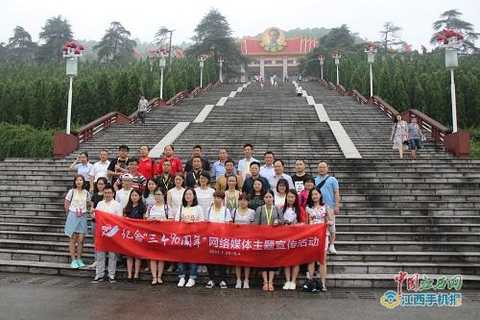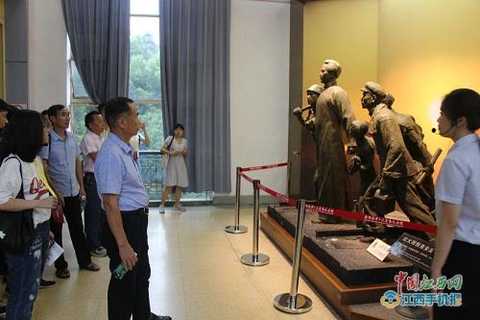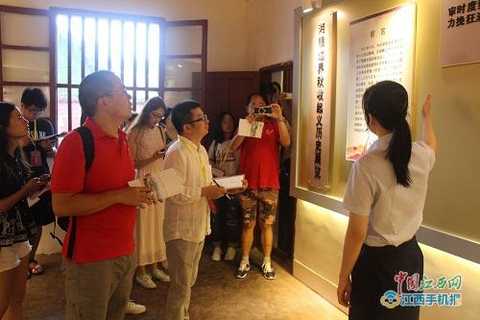[Memorial of the "Three 90th Anniversaries"] Anyuan: A beautiful piece in the Chinese red map

The interview team visited the Anyuan Road Mine Workers Movement Memorial Hall.
China Jiangxi Network - Pingxiang headlines reporter Wan Bingquan, Chen Cheng reports: into the summer of Jiangxi Anyuan, full of splendid. In this century-old industrial and mining city, the spirit of Anyuan, which has no reconciliation, united struggle, courage to open up, and dare to be the first, has been cast. On the morning of August 1, the morning of August 1st, guided by the Central Network Information Office, the “Three 90th Anniversary†online media theme group hosted by the Jiangxi Provincial Party Committee Propaganda Department and the Jiangxi Provincial Party Committee’s Network Office came to Anyuan. District, from the ignited coal city passionate incision - Anyuan Road Mine Workers Movement Memorial Hall, feel the red revolutionary style on this hot land.
National Patriotism Education Demonstration Base - Pingxiang Autumn Harvest Uprising Monument
Anyuan is a district under the jurisdiction of Pingxiang City. More than 80 years ago, there was a reputation of “Little Moscowâ€, and many people with lofty ideals were immersed in this hot land. With the oil painting "Mao Zedong going to Anyuan" and the modern Peking Opera "Du Fushan" popular in the country, Anyuan is well known in China. Anyuan District is the central city of Pingxiang City. According to historical records, the origin of Pingxiang has a vivid legend: during the Spring and Autumn Period and the Warring States Period, Chu Zhao Wang Dujiang had different fruits, as big as a bucket, red as a day, cut and eat, sweet as honey. It was said that the ministers did not have their names, and they asked people to ask for Confucius. Confucius said that the "Ping Shi" is a symbol of good fortune. Later, people called the place where Chu Zhao Wang was a plain, called Pingxiang, the “hometown of Pingshiâ€. In this city, there is the autumn harvest uprising square in the largest square in the south of the Yangtze River. The center of the square stands tall with an autumn harvest uprising monument with a height of 30.9 meters and covering an area of ​​151 square meters. The Autumn Harvest Uprising Square is a commemorative plaza built to commemorate the autumn harvest uprising. It covers an area of ​​247 acres, with the Zhaoping Bridge as the center and the Pingshui River as the link. The square focuses on the autumn harvest uprising monument. The colorful music fountain and the magnificent autumn harvest uprising memorial hall on the south-center axis are important signs of Pingxiang urban activity center and urban style.
The Pingxiang Autumn Harvest Uprising Monument was completed on August 27, 2000 in Pingxiang City. The Pingxiang Autumn Harvest Uprising Monument has been announced by the Central Propaganda Department as the second batch of national patriotic education demonstration bases. The monument body consists of three reliefs. The left and right sides of the monument are “a riot†and “the red light of Zhangjiawanâ€.

The interview team visited the National First Class Museum, the Anyuan Road Mine Workers Movement Memorial Hall, to experience the red revolution in this hot land.
Great man Mao Zedong and his comrades lead Anyuan workers to victory one after another
At 8 o'clock in the morning, the interview group departed from the vicinity of the Pingxiang Municipal Party School, visited the former site of the Zhangjiawan Autumn Harvest Uprising Military Conference and visited the Anyuan Road Mine Workers Movement Memorial Hall. It has a different feeling: Pingxiang style is unusual.
What attracted the revolutionaries to go to the fire in Anyuan? Through the visit, the reporter found the answer in the unyielding figure of the former Anyuan miners: Anyuan was one of the birthplaces of modern Chinese industry. At that time, it was the most concentrated place for industrial workers in Jiangxi. The cruel pressure forced the miners to save the heroic revolution. the power of. Mao Zedong and his comrades-in-arms seized the opportunity of the revolution and led the Anyuan workers to victory one after another.
According to historical records, from the 1920s to the 1930s, a young man with a long blue shirt and a pair of eyes and eyes, Mao Zedong, opened the Xiangjiang River smog, and went to Anyuan 10 times to go deep into the countryside, industrial and mining for social investigation, spread the revolution. The kind of fire. In Anyuan, Mao Zedong and the miners talked with each other and sleep together, and experienced the suffering and suffering of the miners. They understood the enthusiasm and piety of the miners. The deep-seated revolutionary fires were exposed to the blue sky and turned into everything. The torrent of reactionary forces.
In Anyuan, there are many revolutionary sites and memorial sites, telling the story of the great people. Mao Zedong first came to Anyuan to visit the No. 44 Bafangjing; Li Lisan opened the first workers' remedial school Wufu Lane; Liu Shaoqi and the road and mine authorities negotiated and won the Anyuan Public Affairs Building; Mao Zemin served as general manager "Anyuan Road Mine Workers Consumption Cooperative" ... Anyuan, created the "the earliest CCP local party school - Anyuan District Party School" "The earliest party branch of the national industrial workers - Anyuan Road Mine Workers Branch" "China's earliest revolutionary children's organization - Anyuan Children's Group" and other 16 countries are the birthplace of the Chinese workers' movement, the birthplace of the Chinese youth vanguard, the source of the autumn harvest and the main outbreak, in the history of the Chinese revolution, A glorious page was written in the history of labor movement and the history of party building. These 16 national “mostâ€s prove the unique charm of Anyuan’s red history. Anyuan has thus become the cradle of the Chinese workers' movement. Here, the revolutionary's integrity and firmness are flowing, which is the source of the Anyuan spirit.
Mao Zedong and his comrades agreed on a struggle program: I used to be a cow and a horse.
Back pillow Cangshan, Huyu Longpan, this is a memorial hall built according to the shape of the Great Hall of the People. It is surrounded by tall and straight spruce cypress, and the 8th section of 136 steps leads directly to the main entrance of the Anyuan Road Mine Workers Sports Memorial Hall. Above the memorial is the red flag, the torch and the logo of the Anyuan Road Mine Workers Club, which consists of hammers, rock tips, railways and wheel patterns. The "Anyuan Road Mine Workers Movement Memorial Hall" written by Comrade Deng Xiaoping is in the sunshine. Glittering. Under the memorial, there are statues of Mao Zedong, Liu Shaoqi, and Li Lisan: Mao Zedong holds a tarpaulin umbrella and is full of heroic spirits; Liu Shaoqi holds his fists and makes a big sense of anger; Li Lisan is dressed in a long gown, calm and calm. Can not help but recall the age of blood and hurricanes, they led the Anyuan workers to carry out the heroic struggle.

The interview team visited the National First Class Museum, the Anyuan Road Mine Workers Movement Memorial Hall, to experience the red revolution in this hot land.
At the beginning of September 1922, Mao Zedong, secretary of the CPC Xiangtan District Party Committee and director of the labor division secretary, came to Anyuan to investigate the possibility of launching an strike of Anyuan workers and echoing the strikes of workers in Guangdong and Han. Mao Zedong, Liu Shaoqi, Li Lisan, etc. agreed on the struggle program and action plan, and decided to use the basic slogan "Before is a cow and horse, now to be a person", with the goal of increasing wages, improving treatment, and organizing groups, and put forward 17 reasonable demands to the authorities. At 0:00 on September 14th, the strike began. Workers flooded the mine like tidal water and shouted "Strike! Strike!"
On the morning of September 16, the authorities and the martial law commander asked the workers' representatives to discuss the solution. They invited Liu Shaoqi to go to the martial law headquarters, and forced Liu Shaoqi to order the return of work. Liu Shaoqi categorically refused and sternly refuted. Workers everywhere heard the news and came to protect Liu Shaoqi. Thousands of workers surrounded the public housing bureau of the mine bureau where the martial law headquarters was located, and the voice was like thunder: "Whoever dares to move Liu to represent half of the hair, we must fight the roads and mines, the two bureaus will not stay, let the roads and mines The staff must not leave Anyuan!†Finally, the authorities were finally forced to send plenipotentiaries to negotiate with the club, and the three parties formally signed the agreement. History said that the strike "has not hurt one person, has not lost, and has won a complete victory."
The memorial hall also contains the "Anyuan Road Miners' Club Songs" written by the heads of Liu Shaoqi and Li Lisan: the creation of all the world, but my labor; the people who are insulted and oppressed, but my labor. The world, we should be created, oppressed, we must be lifted. Create the world to eliminate oppression and unite my labor.
Blowing the horn of the autumn harvest, becoming a beautiful piece in the red map of China
Zhangjiawan, a remote village in Anyuan District, Pingxiang City. It is in this small village that Mao Zedong convened a famous military conference and blew the horn of the autumn harvest uprising. This originally unknown mountain village has since gone down in history.
The old site of the Zhangjiawan military conference was still the same as that. The seats were already mottled. The faded conference strips still fluttered in the wind. The enamel teacups seemed to be hot, and the air was filled with the tension of the great men when they were planning. atmosphere. This is a red landscape that is already cold and lonely. It is this landscape and even thousands of such landscapes. It depicts contemporary China with flowers.
At the foot of Wugong Mountain, where the clouds are in the air, and the nine-day sun and the moon can be shouldered, the seal of the autumn harvest uprising commander Lu Deming is located between Cangshan Green Water. The military talent who came out from the poor farmer in Sichuan practiced his life to solve the promise of not being able to figure out his body. Qingshan has the privilege of burying its loyal bones. So far, we can still imagine the tragic wars of the past. After Red Anyuan deduced a series of revolutionary movements, Mao Zedong and his colleagues have already mastered China's direction and eventually led China to a magnificent path of seeking independence and prosperity.
According to the "Pingxiang Military Records", in mid-August 1927, Mao Zedong, an alternate member of the Provisional Political Bureau of the CPC Central Committee, a special commissioner, and a member of the Standing Committee of the Hunan Provincial Party Committee, and Peng Gongda, secretary of the CPC Hunan Provincial Committee, according to the decision of the Hunan Provincial Party Committee, will be the CPC. The source special district committee was reorganized into a city and organized an action committee to prepare for the autumn harvest uprising. On September 9th, the autumn harvest uprising officially started. After many days of fighting, the insurgent troops suffered heavy losses, and the commander Lu Deming unfortunately sacrificed. Mao Zedong was forced to transfer, and the officers and men formed in Anyuan were dispersed into various companies. At the beginning of October, the troops arrived in Ningkang County and began the great struggle to create the Jinggangshan Revolutionary Base. Although I only stayed in Anyuan for a few days, I asked the martyrs, the great men, and the past, and they became more and more as part of Anyuan. It seems that we have also rushed to the front to fight for the people's livelihood and civil rights. Today, Anyuan has been integrated into the classic line of red tourism, and is integrated with Jinggangshan and Lushan, becoming a beautiful piece in the red map of China.
(Editor: Ji Liya HN003)
Shenzhen MingFengXing Art & Craft Products CO., LTD. , https://www.goodkeyring.com